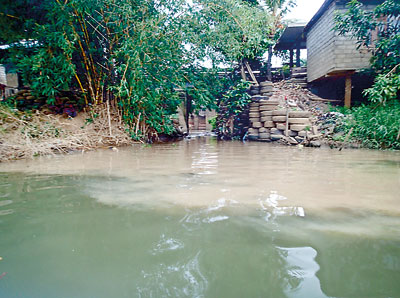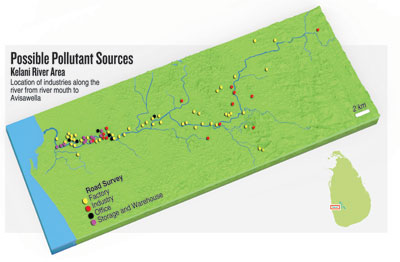News
Pollution hotspots along Kelani mapped

Waste on the river bank
All the main pollution sources along the Kelani River have been mapped by the Environmental Foundation Limited (EFL) to prevent a repeat of the disastrous leakage of diesel fuel into the river in August last year.
Flowing through highly-populated and highly-industrialised zones the Kelani, Sri Lanka’s fourth-longest river, is also its most polluted waterway. Waste discharge from rapidly-multiplying industries located alongside its banks, agricultural runoff and domestic and municipal wastes, including ad hoc dumping of municipal solid waste, are the main sources of pollution of the Kelani River.
The EFL has studied the river’s most polluted area from Avissawella to the river’s outflow – about 40km.
With financial support from The Asia Foundation, EFL surveyed the river to identify nearby industries that could pose a threat to the health of the river through direct discharge or spills of chemicals and disposal of waste. The survey documented the type of the industry and their GPS locations among other details pertaining to the industry. Data on water quality was also collected.
To set up a factory or large project, an Environment Protection Licence (EPL) needs to be obtained and approval through an Environmental Impact Assessment (EIA). The EFL points out that while existing policy and legislations for curtailing industrial pollution are firm, there is a need for effective enforcement of law and a highly stringent monitoring mechanism to verify all standards are met.
These licences need to be renewed periodically – every one, three or more years – and that is the only time checks are carried out to establish whether an industry adheres to standards. “Unless there is a complaint there is no proper monitoring process of whether these industries adhere to agreed standards,” EFL project coordinator, Dhiya Sathananthan said.
The EFL believes it is vital for the Central Environmental Authority (CEA) to move from being a reactive compliance monitoring (complaint based) body to a proactive compliance monitoring (regular monitoring) organisation.
Aware of the CEA’s current limited resources the EFL is empowering local communities to be environmental monitors, Ms.Sathananthan said. It has carried out a series of training programs for community-based organisations in the highest-impact areas of the Kelani River.

A canal bringing pollutants to the river
The workshops aimed to educate local community to improve the river water quality and to minimise any further disasters caused by effluent discharged by industries as well as residents.
“Through these training programs community-based organisations were trained extensively on preventing pollution as well on pollution monitoring and identifying sources of pollution. The workshops saw a positive response, with participants enthusiastic about monitoring pollution discharges along the river and reporting their findings to the CEA, EFL or other environmental organisations,” Ms.Sathananthan stated.
In a report, the EFL has made several recommendations to prevent future pollution of the river. All new industries should be located in designated industrial zones and stand-alone industrial siting should be prohibited. The setting up of high-polluting industries in ecologically sensitive river basins and water-bodies should also be prohibited. The CEA should consider introducing toxicology assessments, the report further states.
In addition to the location of industries, the EFL project team observed a number of canals and drains emptying into the river. Heavy foam was observed in water discharged from some canals, probable evidence of industrial discharge. Canals in urban areas from Peliyagoda to Kelaniya carried domestic discharge.
The Kelani supplies water to the commercial and administration capital of Sri Lanka – about 500,000 people in Colombo and the periphery – so it is important to reduce pollution for the health and safety reasons as well as for the benefit of biodiversity, the EFL said.


